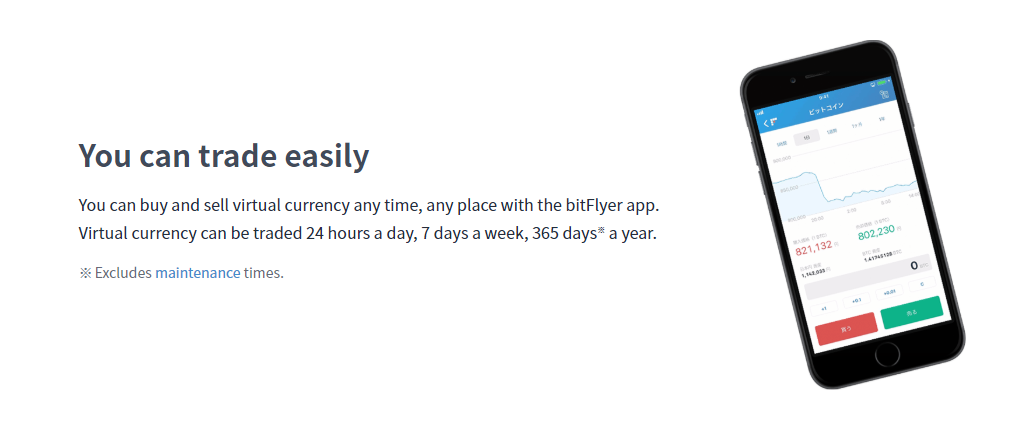
BitFlyer

Frais de l'echange
Méthodes de dépôts
Cryptos prises en charge (15)
BitFlyer Review
What is BitFlyer?
BitFlyer’s is one of the big dragons in the crypto exchange world. It is from Japan, and launched on 9 January 2014. The land of sushi and ninjas not only has an impressive cultural heritage, they also have plenty of crypto exchanges, but BitFlyer is generally considered the largest one. There is a lot of support for this statement as well. One example is the Virtual Currency & Cryptocurrency Trading Services Questionnaire, made by Macromill Internet Research, that showed that Bitflyer was indeed the most used crypto exchange in Japan.
This review focuses on the “original BitFlyer”, i.e. BitFlyer Japan. But there’s also, presumably due to regulatory reasons, a BitFlyer Europe and a BitFlyer USA.
BitFlyer Advantages
The exchange states on its website that it is global, powerful and secure.

US-investors
US-investors may trade at BitFlyer, but only at another entity of the BitFlyer company group, named BitFlyer USA.
Trading Volume
On the date of last updating this review (2 December 2021), the 24-hour trading volume was USD 286.7 million, according to Coinmarketcap. The same value 18 months earlier (on 18 March 2020) was only USD 82.1 million. This growth is definitely a good sign for the exchange, but there is still some distance to cover before BitFlyer is among the top 10 exchanges in the world in terms of the trading volume. On 2 December 2021, Binance had the highest 24-hour trading volume of approximately USD 30 billion in spot markets...
OTC
Let’s say that you hold a very large amount of a certain cryptocurrency. You want to sell that amount. Should you do that in the ordinary orderbook at a regular trading platform like everyone else? Maybe not. One of many reasons for executing large trades outside of the normal market place is that large trades may affect the market price of the relevant crypto. Another reason, which is connected to the foregoing, is that the order book might be too thin to execute the relevant trade. A solution to these problems is what we call OTC-trading (Over The Counter).
BitFlyer offers OTC-services to its users, which might be helpful to all the users who trade in larger volumes.
Mobile Support
This platform is not only available from your desktop, you can also access it via your mobile. Most traders in the crypto world today carry out their trades via desktop (around 70% or so). However, there are naturally people out there that want to do it from their smart phone as well. If you’re one of those people, then this platform can still be for you.

BitFlyer Trading View
Different exchanges have different trading views. And there is no “this overview is the best”-view. You should yourself see which trading view that suits you the best. What the views normally have in common is that they all show the order book or at least part of the order book, a price chart of the chosen crypto and order history. They normally also have buy and sell-boxes. Before you choose an exchange, try to have a look at the trading view so that you can see that it feels right to you. The below is a picture of the advanced version of the trading view at BitFlyer (in the advanced Pro Exchange, there is also a more straight-forward version called Easy Exchange):

BitFlyer Fees
BitFlyer’s fees consist of deposit fees, trading fees and withdrawal fees.
Deposit fees vary dependent upon how you deposit.
Trading fees are 0.20% flat, meaning that takers and makers both pay 0.20% of the total order value of the trade as a fee to BitFlyer.
Withdrawal fees are fixed at 0.0008 BTC for BTC-withdrawals.
More on these fees below.
BitFlyer Trading fees
Many exchanges charge what we call taker fees, from the takers, and what we call maker fees, from the makers. Takers are the people removing liquidity from the order book by accepting already placed orders, and makers are the ones placing those orders. The main alternative to this is to simply charge “flat” fees. Flat fees mean that the exchange charges the taker and the maker the same fee.
This platform offers flat fees. It charges both takers and makers 0.20%. The global industry average has for a long time been around 0.25%. Many exchanges have now started reducing their trading fees even lower, but we think it’s fair to say that BitFlyer’s trading fees still are still in line with the global industry average.
BitFlyer Withdrawal fees
The platform charges a withdrawal fee amounting to 0.0004 BTC when you withdraw BTC. This fee is also somewhat below the industry average, which - the last time we did an empirical study of all exchanges' withdrawal fees - was slightly above 0.0006 BTC per BTC-withdrawal.
Deposit Methods
BitFlyer accepts deposits through both wire transfer and credit cards. Many crypto investors of course view this as very positive. It also makes BitFlyer what we call an “entry-level exchange”, where new crypto investors can take their first steps into the thrilling crypto world.
When speaking of deposit methods, we must also mention that BitFlyer actually accepts PayPal-payments. Not many exchanges let their users pay via PayPal, so this is a feather in the hat for BitFlyer.
However, it should be noted that for BitFlyer Japan, you can only make payments with Japanese credit cards.